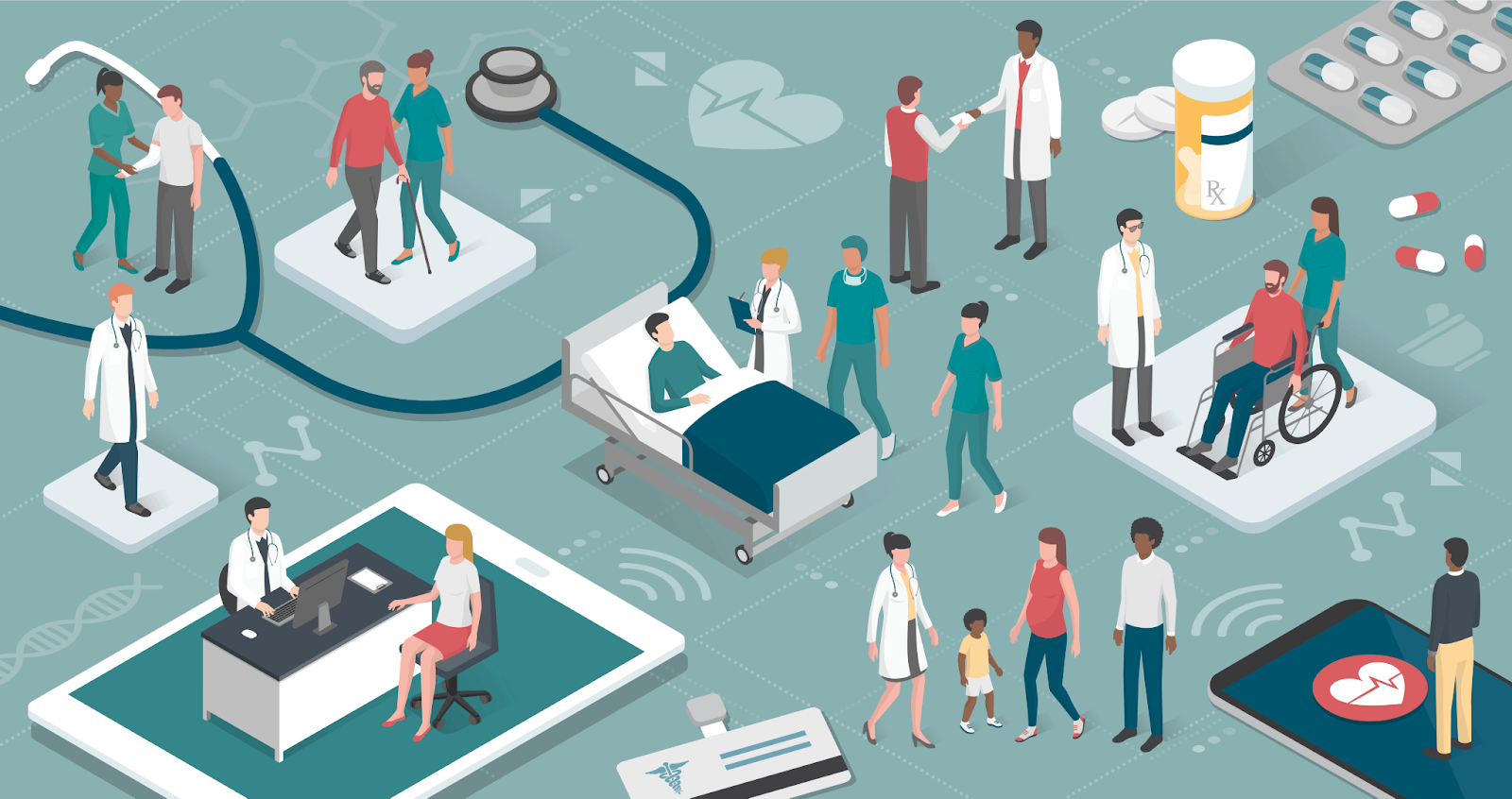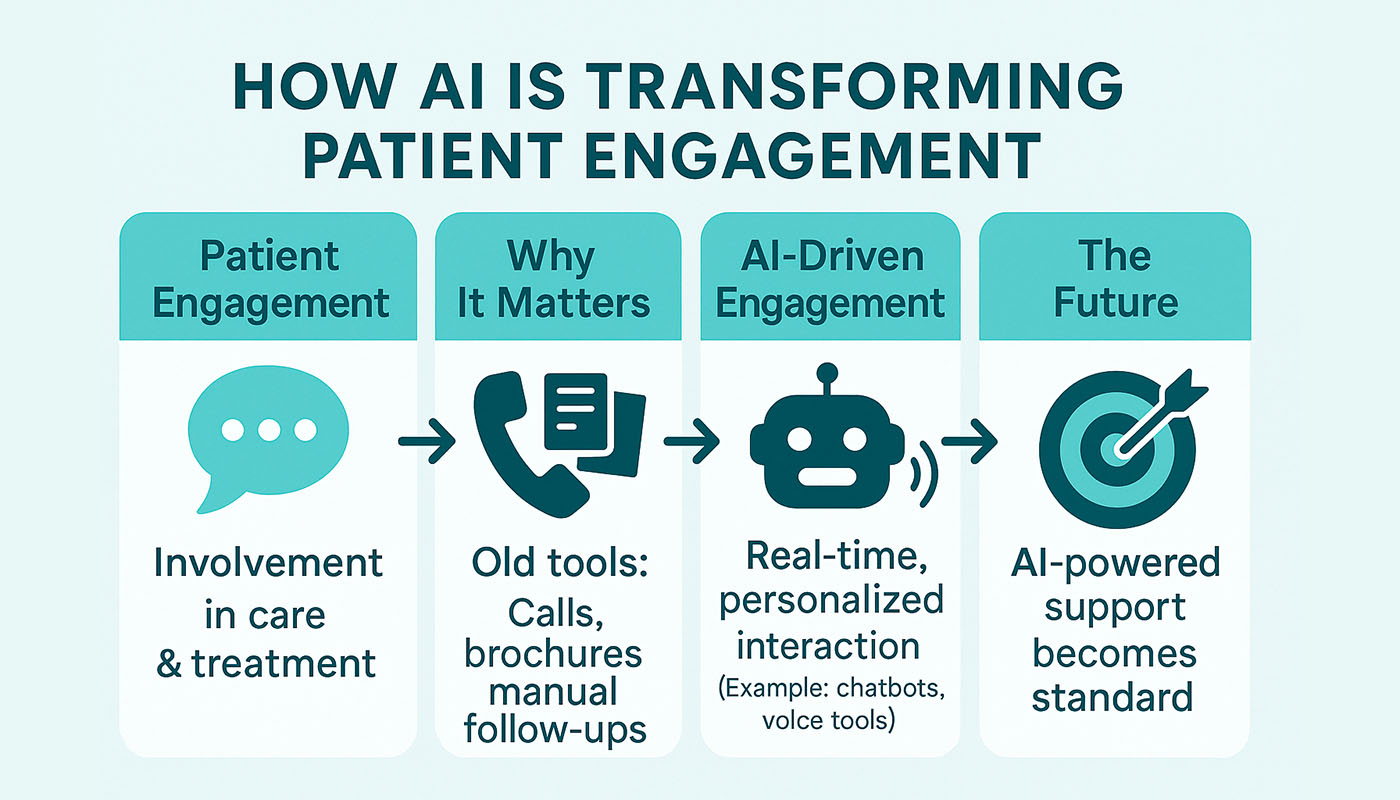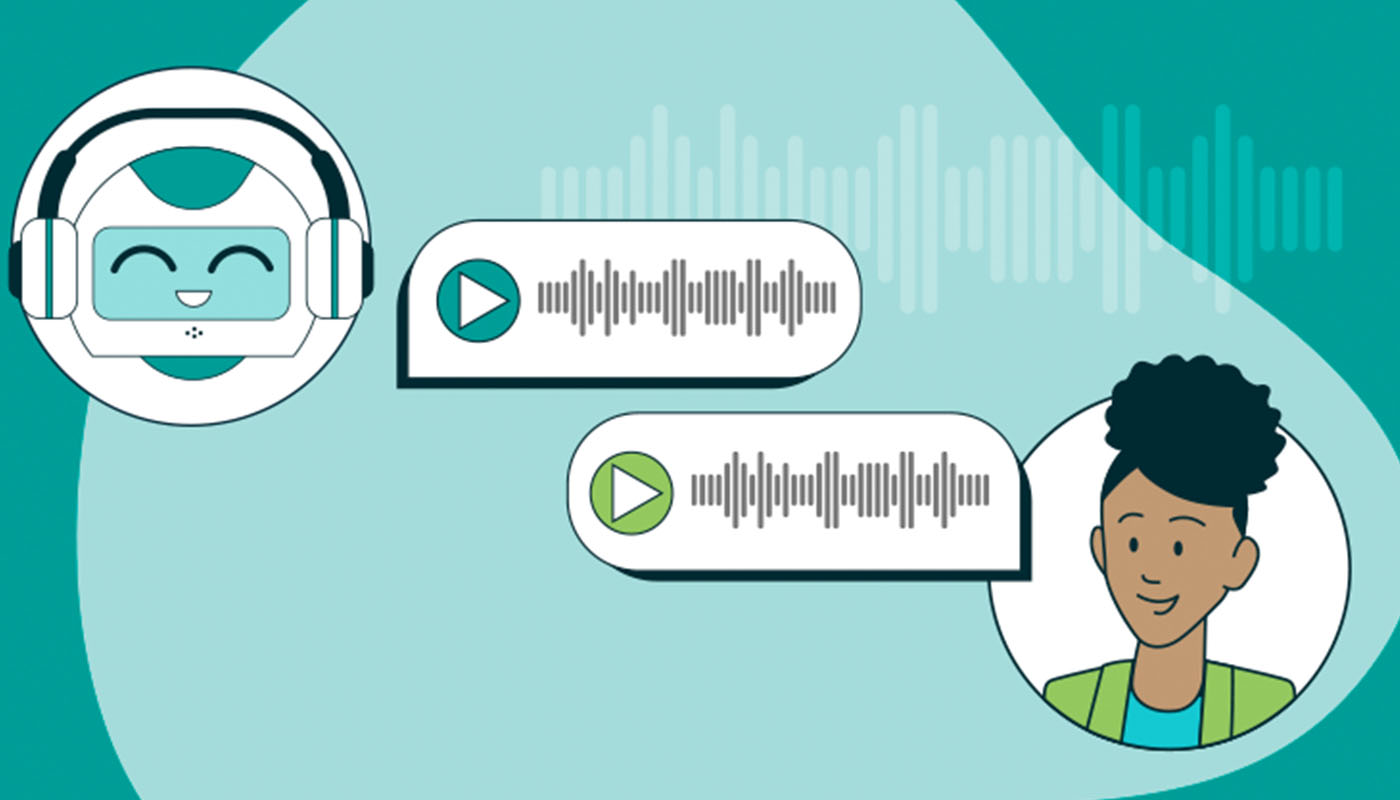Modern healthcare is shifting toward active patient involvement. People want fast answers, clear instructions, and care that fits their needs.
Old tools like phone calls and forms no longer work well. They are slow and often miss the right moment.
AI solves this by offering real-time, personalized communication. It helps clinics stay connected with patients at every step.
Graphlogic.ai builds tools like chatbots and voice assistants that reduce no-shows, support treatment, and improve trust. AI is becoming essential for better care.

What Is Patient Engagement in Healthcare?
Patient engagement means how people take part in their care and communicate with providers. It includes understanding diagnoses, asking questions, and following treatment plans. Engaged patients recover faster and are less likely to be readmitted.
The Agency for Healthcare Research and Quality (AHRQ) links engagement to fewer errors, better outcomes, and higher satisfaction. It also helps hospitals lower costs and work more efficiently.
Traditional tools like calls, brochures, and follow-ups are slow and depend on staff time. They often miss the right moment to help.
AI improves this with real-time, personalized communication. Graphlogic.ai uses chatbots and voice tools to send reminders, answer questions, and adjust messages based on language and patient history.
This keeps patients informed and lowers the burden on staff. As AI becomes more common, this kind of support is becoming the new standard in healthcare.
The Role of AI in Enhancing Communication
AI enhances communication by making it more immediate and tailored. Natural language processing (NLP) allows systems to understand and respond to human language. This means patients can ask questions and receive accurate, clear answers without waiting for office hours.
AI also enables real-time feedback loops between providers and patients. For example, Graphlogic.ai’s Agentic AI uses both chatbots and voice assistants to offer consistent, context-aware responses. These tools connect with CRM systems and medical records to provide more personalized answers.
Hospitals using such tools report reduced response times and lower workloads for administrative staff. These results are backed by reports from Healthcare IT News, which show AI-driven communication helps reduce patient frustration and improves retention.
Real-Time Interaction with AI Chatbots and Voice Bots
AI chatbots and voice bots now handle key communication tasks in many clinics. They schedule visits, answer questions, confirm appointments, and guide patients through symptom checks — any time of day. This reduces staff workload and improves response times.
Graphlogic.ai’s Agentic AI supports these features across web, mobile, and IVR channels. It works in over 32 languages, helping providers reach diverse patient groups without relying on interpreters. This is especially valuable in multilingual regions or underserved communities.
Clinics using Agentic AI have cut no-shows by up to three times. The system sends automated reminders 48 and 6 hours before appointments. If patients do not confirm, it offers to reschedule. Reminders are personalized based on language, preferences, and visit type.
These tools also improve the patient experience. People get clear next steps without waiting or calling. They are more likely to show up and follow care plans.
As noted by Becker’s Hospital Review, AI bots are especially useful in high-volume settings like emergency rooms and during outbreaks. They free staff to focus on urgent care while bots handle routine interactions.
To be effective, these bots must connect with EHR and CRM systems. Solutions like Graphlogic’s are designed for this integration and work well in clinics with complex or multilingual workflows.

Automating Follow-Ups and Appointment Reminders
Follow-up communication is often neglected due to staff shortages or workload. AI fills this gap by automating messages related to post-visit care, lab results, or rescheduling.
Automated reminders reduce no-shows and free up time for medical staff. They also help clients remember key steps in their care plan. For example, Graphlogic’s solutions use RAG systems (Retrieval-Augmented Generation) to tailor each message based on previous patient history.
This approach is more effective than traditional bulk SMS or calls. It integrates with medical systems to track responses and escalate unconfirmed appointments automatically.
Personalized Health Tips and Medication Management
AI also helps people manage their health between visits. It delivers health tips based on patient history, demographics, and treatment goals. These suggestions are not general — they are contextual.
Medication adherence is one of the most impactful areas. People often forget doses or run out of refills. AI tools can send personalized reminders and alert providers if patterns suggest non-compliance.
Solutions like VoiceBox from Graphlogic.ai also support voice-based reminders, making them more accessible for elderly people or those with vision issues.

Case Study: Reducing No-Shows by 3x
A mid-sized outpatient clinic in Southeast Asia was struggling with a high rate of missed appointments. Many of their patients were working professionals or older adults who often forgot appointments or had difficulty rescheduling. Staff were spending several hours a day manually calling people, leaving voicemails, or sending messages that often went unread.
To address this, the clinic began using Graphlogic’s Agentic AI. The system was integrated into their existing CRM and appointment platform. It included multilingual chatbots and automated voice calls that worked across both mobile and landline numbers. The bots handled reminders, confirmations, and rescheduling through a simple conversational interface.
Over the course of two months, the clinic noticed a clear improvement. Missed appointments dropped significantly. Staff had more time to focus on patient care rather than making phone calls or following up manually.
Here are the results they reported after 60 days:
| Metric | Before AI | After AI (60 days) |
| No-show rate | Around 21% | Reduced to 7% |
| Manual reminder calls per day | 30–50 | Fewer than 10 |
| Average reminder lead time | 12–24 hours | 48 and 6 hours |
| Supported languages | 2 (staff-based) | 6 (AI-managed) |
| Rescheduling handled by staff | Fully manual | 80% automated |
| Satisfaction feedback | Mostly neutral | Mostly positive |
The reminders were sent in each patient’s preferred language. Most people received a short message or voice call two days before the appointment and another on the morning of the visit. If they replied that they could not attend, the system offered a reschedule option without needing to call the clinic.
This helped the clinic recover otherwise lost slots and improve day-to-day scheduling. Administrative workload went down by about 40 percent, based on internal tracking. Staff felt less pressure, and patients appreciated having flexible options without waiting on hold or navigating complex menus.
What made this project successful was not just the technology. It was how easily the AI system fit into the clinic’s existing workflow. There was no need to hire new staff or replace their software. The bots adapted to their current tools and processes, which made adoption simple and low-risk.
This case shows that AI does not have to be complicated or disruptive to have an impact. Small steps like automating reminders and offering self-service options can lead to meaningful improvements in patient engagement and operational efficiency.
How AI Builds Trust and Improves Retention
Consistency matters in healthcare communication. AI systems provide accurate information every time. This reliability helps build people trust — especially when AI answers align with physician guidance.
When patients feel understood, they’re more likely to return. AI plays a role here by remembering preferences, tracking responses, and avoiding repeated questions. It also avoids emotional bias and communicates clearly under pressure.
Of course, human care is still vital. AI does not replace it but rather supports it by reducing repetitive tasks and improving reach. As noted by Forbes Health, blending AI with human empathy is key to long-term loyalty.
Future Trends in AI-Powered Patient Engagement
AI in healthcare is moving fast. What once felt experimental is now part of daily clinical work. The next wave will bring more personalization, prediction, and smarter tools for both patients and providers. Several trends are shaping this future.
- Integration with wearable devices
Smartwatches and fitness trackers monitor heart rate, sleep, and activity. Linked to AI, this data becomes more useful. It can flag early changes in health and help adjust care plans in real time. A drop in sleep quality or activity, for example, can trigger a prompt for follow-up. - Predictive analytics for earlier care
AI reviews large sets of patient data to spot early signs of chronic disease or complications. It helps doctors act sooner and tailor treatment. These tools also identify high-risk groups for outreach and education. In cases like diabetes or recovery, early warnings can prevent serious issues. - More human interaction with voice cloning
Generic machine voices often feel cold. Graphlogic’s VoiceBox uses voice cloning to make reminders and updates sound natural and familiar. This supports elderly people, those with vision issues, or anyone who responds better to a warm, local voice. - On-premise AI for sensitive data
Data privacy rules now push many hospitals to avoid cloud-based systems. On-premise AI helps meet these standards and gives providers full control over data. Graphlogic.ai supports this setup in regions like the Gulf, Southeast Asia, and Latin America. - Rising need for explainable, ethical AI
As AI takes on more clinical tasks, transparency is key. Clinicians need to know how decisions are made. Explainable AI will matter most in areas like diagnosis or mental health. It helps build trust and meet regulatory demands.
Challenges remain. AI can reflect bias from training data and struggles with outdated IT systems. Many hospitals still lack the infrastructure for real-time AI use.
Even so, the value is growing. AI is already changing how care is delivered and how patients stay involved. For healthcare teams planning ahead, now is the time to focus on clean data, strong systems, and tools that scale.
FAQ
It refers to how people participate in their own care and interact with providers.
It offers 24/7 support, uses natural language understanding, and personalizes messages.
Yes. Automated reminders and rescheduling tools cut no-shows significantly.
Expect more predictive analytics, wearable integration, and smarter virtual assistants.

